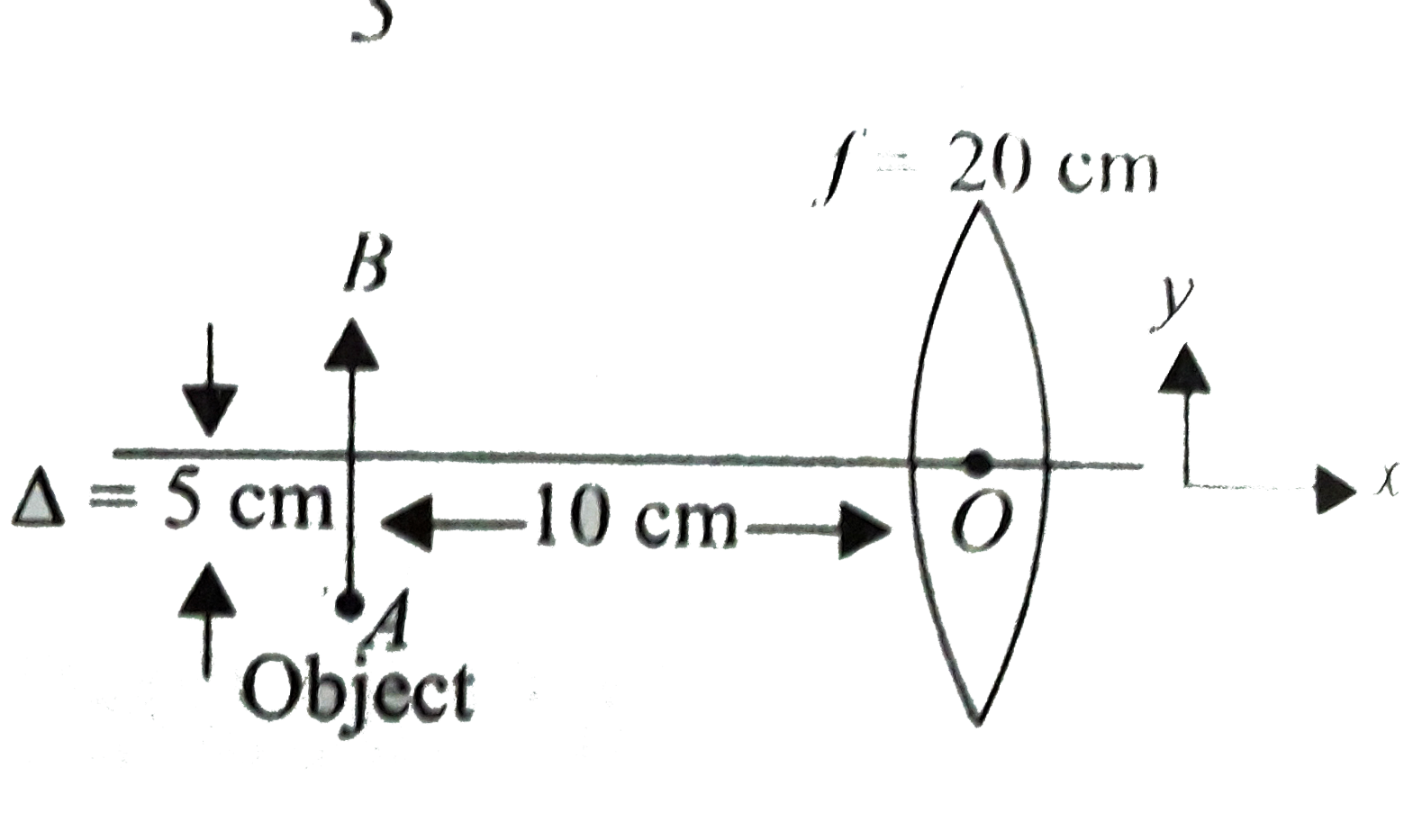A linear object of size 1.5cm placed at 10cm from a lens of focal length 20cm. The optic centre of lens and the object are displaced a distance Δ. The magnification of the image formed is m (Take optic centre as origin). The coordinates of image of A and B are (x1,y1) and (x2,y2) respectively. Then

(x1,y1)=(−20cm,−1cm)
(x2,y2)=(−20cm,2cm)
m=3
m=2
The correct Answer is:a.,b.,d.
u=−10cm,f=20cm
1u−1v=1f
1v=120−120=1−220=−120⇒v=−20cm
Magnification m=vu=−20−10=2
Height of image =1.5×2=3cm
The y1 coordinate of a point A on the image will be
y1=(0.5)×2=−1cm
The y2 coordinate of a ppoint B on the image will be
y2=1×2=2cm

Topper's Solved these Questions
- GEOMETRICAL OPTICSBOOK - CENGAGE PHYSICSCHAPTER - GEOMETRICAL OPTICSEXERCISE - Assertion-Reasoninig
2 Videos
- GEOMETRICAL OPTICSBOOK - CENGAGE PHYSICSCHAPTER - GEOMETRICAL OPTICSEXERCISE - Linked Comprehension
51 Videos
- GEOMETRICAL OPTICSBOOK - CENGAGE PHYSICSCHAPTER - GEOMETRICAL OPTICSEXERCISE - Subjective
26 Videos
- FRICTIONBOOK - CENGAGE PHYSICSCHAPTER - FRICTIONEXERCISE - QUESTION BANK
1 Videos
- GRAVITATIONBOOK - CENGAGE PHYSICSCHAPTER - GRAVITATIONEXERCISE - Question Bank
39 Videos
Similar Questions
An object is held at a distance of 20cm from a concave lens of focal length 80 cm. What is the position and size of the image if the object is 2 cm high ?
View SolutionAn object of height 2 cm is placed in front of a convex lens of focal length 20 cm at a distance of 15 cm from it. Find the position and magnification of the image.
View Solution
Knowledge Check
A linear object of size 1.5cm is placed at 10 cm from a lens of focal length 20 cm. The optic centre of lens and the object are displaced are displaced a distance Δ. Thed magnification of the image formed is m. (Take optic centre of origin). The coordinates of image of A and B are (x1,y1) and (x2,y2) respectively then
 A(x1,y1)=(−20cm,−2cm)B(x2,y2)=(−20cm,2cm)Cm=5Dm=4
A(x1,y1)=(−20cm,−2cm)B(x2,y2)=(−20cm,2cm)Cm=5Dm=4A linear object of size 1.5cm is placed at 10 cm from a lens of focal length 20 cm. The optic centre of lens and the object are displaced are displaced a distance Δ. Thed magnification of the image formed is m. (Take optic centre of origin). The coordinates of image of A and B are (x1,y1) and (x2,y2) respectively then
 A(x1,y1)=(−20cm,−2cm)B(x2,y2)=(−20cm,2cm)Cm=5Dm=4
A(x1,y1)=(−20cm,−2cm)B(x2,y2)=(−20cm,2cm)Cm=5Dm=4An object is placed at a distance of 20 cm from a convex lens of focal length 10 cm . The image is formed on the other side of the lens at a distance
A20 cmB10 cmC40 cmD30 cm
An object is placed at the focus of concave lens having focal length /. What is the magnification and distance of the image from the optical centre of the lens ?
View SolutionAn object of height 1.5 cm is placed on the axis of a convex lens of focal length 25 cm . A real image is formed at a distance of 75 cm from the lens. The size of the image will be
View SolutionA 5 cm tall object is placed perpendicular to the principle axis of a convex lens of focal length 20 cm. The distance of the object from lens is 30 cm. Then, position and size of image formed is
View SolutionAn object 1.5 cm high is placed 10 cm from the optical centre of a thin lens. Its image is formed 25 cm from the optical centre on the same side of the lens as the object. The height of the image is
View SolutionDistance of an object from a concave lens of focal length 20 cm is 40 cm. Then linear magnification of the image
View Solution
